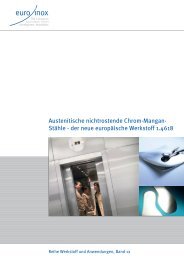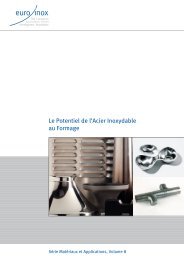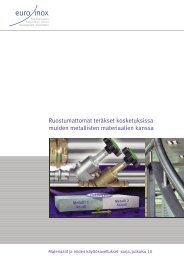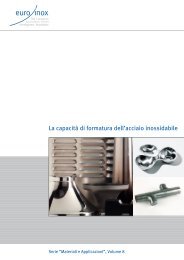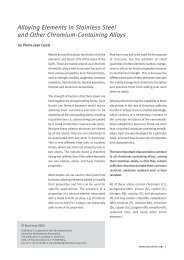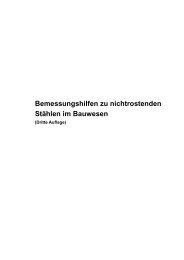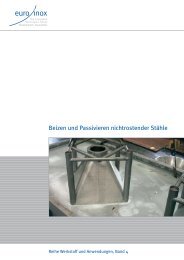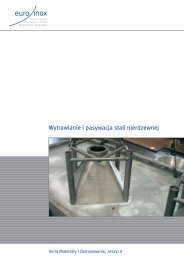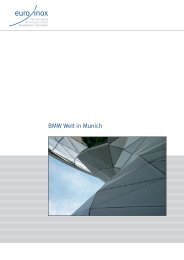Stainless Steel - The Safe Choice - Euro Inox
Stainless Steel - The Safe Choice - Euro Inox
Stainless Steel - The Safe Choice - Euro Inox
Create successful ePaper yourself
Turn your PDF publications into a flip-book with our unique Google optimized e-Paper software.
SAFE STAINLESS STEEL<br />
Both acute and chronic toxicity from chromium<br />
are mainly caused by hexavalent chromium<br />
compounds (Cr VI). If taken orally,<br />
soluble hexavalent chromium would be reduced<br />
to the desirable trivalent chromium<br />
before being absorbed in the small intestine.<br />
In the case of stainless steel utensils or food<br />
process equipment, any chromium released<br />
from the cooking processes will be in the trivalent<br />
state and no toxicity is to be expected.<br />
Not only it is non toxic but it can be<br />
beneficial to health.<br />
4.2 <strong>The</strong> essential character of Nickel<br />
Nickel is the 28th element on the periodic chart<br />
and is situated between cobalt and copper.<br />
It is a metallic element belonging to the group<br />
of “transition metals” (Group VIII) like iron<br />
and cobalt, and has an atomic weight of 59.<br />
Nickel is the 24th most abundant element in<br />
the Earth’s crust at about 80 ppm.<br />
<strong>The</strong> need for nickel in the diet of animals has<br />
been proven (4,5) but the ubiquitous nature<br />
of nickel makes it difficult to establish its<br />
need in the human diet. However, a nickel<br />
dietary requirement for humans of 50 µg/kg<br />
of diet has been proposed by Nielsen (6).<br />
It is impossible to be skin-sensitised to nickel<br />
by the ingestion of nickel compounds, but<br />
some investigators have shown that ingested<br />
nickel may cause exacerbation of hand eczema<br />
in those people who are already sensitised<br />
to nickel. Although only a minority of<br />
people react to oral nickel doses below 1250 µg<br />
(7), it has been concluded that a reduction of<br />
the dietary intake of nickel may be beneficial<br />
for some already nickel sensitised people (8).<br />
In contrast, it has been found that oral exposure<br />
to nickel prior to sensitisation results in<br />
a reduced frequency of nickel hypersensitivity.<br />
That conclusion was reached from a survey<br />
(9) of persons who had oral contact with<br />
nickel at an early age prior to ear piercing, a<br />
common cause of nickel sensitisation. <strong>The</strong><br />
effectiveness of nickel ingestion as a way of<br />
promoting tolerance to sensitisation by nickel<br />
was subsequently demonstrated (10).<br />
5. Hazard or risk?<br />
It is worth defining these items. <strong>The</strong> hazard of<br />
a metal or a metallic alloy is its “potential” to<br />
cause harm and it is one way of expressing the<br />
(adverse) “intrinsic properties” of a metal or<br />
a metallic alloy. Hazard identification for a<br />
metallic alloy, (i.e. the determination of adverse<br />
effects which an alloy has a potential<br />
capacity to cause) must be based on the physical,<br />
chemical and toxicological properties of<br />
the alloy. Consequently, hazard identification<br />
should take into account the physical<br />
forms of an alloy (massive form or powdered<br />
form) and its chemical properties paying particular<br />
attention to its corrosion resistance in<br />
a different set of media.<br />
<strong>The</strong> risk posed by a metallic alloy is a probability<br />
function and is the likelihood of harm occurring.<br />
It depends on the exposure to the<br />
(hazardous) metallic alloy. For simplicity :<br />
Risk = Hazard x Exposure<br />
© <strong>Euro</strong> <strong>Inox</strong> 2002 www.euro-inox.org · 4



